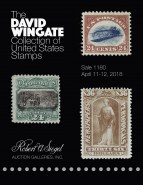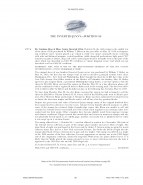⇚ Position 86 - 2018-04-12 Transaction Summary
Purchase Date:
2018-04-12
How Purchased:
Auction
Where Purchased:
Siegel Auction Galleries
Auction No.:
1180-The David Wingate Collection
Lot No.:
408
Sound/Fault:
Fault
Catalogue Value:
$ 450,000
Realized:
$ 483,800
Seller:
Buyer:
Description
24c Carmine Rose & Blue, Center Inverted (C3a). Position 86, the sixth stamp in the eighth row of the sheet of 100 purchased by William T. Robey at the post office on May 14, 1918, accompanying certificate notes "mount glazed o.g." which is really very minor, unusually choice centering with wide and balanced margins, vertical guideline visible along left perforations, light pencil "86" notation on gum as always, deep rich colors, natural gum bend as normally seen in this part of the sheet which was described on 1981 P.F. certificate as "minor diagonal crease" and which was not described at all on 1989 P.F. certificate
EXTREMELY FINE. THIS IS ONE OF THE BEST-CENTERED EXAMPLES OF THE 1918 24-CENT INVERTED JENNY. A TRULY REMARKABLE STAMP.
The original sheet of one hundred Inverted Jenny errors was purchased by William T. Robey on May 14, 1918, the first day the stamps went on sale in all three principal airmail route cities: Washington, D.C., New York and Philadelphia. Robey bought the sheet for its $24 face value at the New York Avenue Post Office window in the District of Columbia. On Sunday, May 19, Robey agreed to give Eugene Klein, a prominent Philadelphia stamp dealer, a one-day option to buy the sheet for $15,000. Klein exercised his option on Monday, May 20, in a late afternoon phone call, and he confirmed it with a registered letter to Robey sent in the evening mail. The sheet was delivered to Klein’s office by Robey and his father-in-law on the following day, Tuesday, May 21, 1918.
No later than Monday, May 20, the day Klein exercised his option, he had arranged to sell the sheet for $20,000 to Colonel Edward H. R. Green. Half of the $5,000 profit went to Klein’s partners, Percy McGraw Mann and Joseph A. Steinmetz. Klein was then authorized by Colonel Green to divide the sheet into singles and blocks, and to sell all but a few key position blocks.
Despite the great rarity and value of Inverted Jenny stamps, many of the original hundred have been mistreated by collectors over the years. Colonel Green himself allowed moisture to affect some of the stamps he retained. Eight straight-edge copies that Klein was unable to sell and returned to Colonel Green were found in Green’s estate stuck together in an envelope (they were soaked and lost their gum). Other examples have become slightly toned from improper storage and climatic conditions. Hinge removal has caused thins and creases in numerous stamps, and one was physically Scotch-taped to an exhibit page. Another was nearly lost to philately forever when it was swept up in a vacuum cleaner.
The stamp offered here -- Position 86 -- was first offered at auction in a November 1944 sale of the Colonel Green collection as part of the unique plate number and arrow block of eight. The plate block of eight was purchased at the Green sale by dealer Y. Souren acting as agent for noted collector Amos Eno, heir to a New York real estate fortune. Eno broke the block of eight into the unique plate block of four, a bottom arrow pair, and two singles. This stamp was offered as a single in the 1950 auction of the Eno collection. Its next appearance at auction was in the 1999 Siegel sale of the “Argentum’ collection, formed by long-time Weill client, Dr. James Alden Graves. It is likely that the Weills placed the stamp privately in one or more collections between the time it appeared in the 1950 Eno sale and the 1999 Siegel sale.
Ex Colonel Edward H. R. Green, Amos Eno and Dr. J. A. Graves (“Argentum”).
With 1981 and 1989 P.F. certificates.
EXTREMELY FINE. THIS IS ONE OF THE BEST-CENTERED EXAMPLES OF THE 1918 24-CENT INVERTED JENNY. A TRULY REMARKABLE STAMP.
The original sheet of one hundred Inverted Jenny errors was purchased by William T. Robey on May 14, 1918, the first day the stamps went on sale in all three principal airmail route cities: Washington, D.C., New York and Philadelphia. Robey bought the sheet for its $24 face value at the New York Avenue Post Office window in the District of Columbia. On Sunday, May 19, Robey agreed to give Eugene Klein, a prominent Philadelphia stamp dealer, a one-day option to buy the sheet for $15,000. Klein exercised his option on Monday, May 20, in a late afternoon phone call, and he confirmed it with a registered letter to Robey sent in the evening mail. The sheet was delivered to Klein’s office by Robey and his father-in-law on the following day, Tuesday, May 21, 1918.
No later than Monday, May 20, the day Klein exercised his option, he had arranged to sell the sheet for $20,000 to Colonel Edward H. R. Green. Half of the $5,000 profit went to Klein’s partners, Percy McGraw Mann and Joseph A. Steinmetz. Klein was then authorized by Colonel Green to divide the sheet into singles and blocks, and to sell all but a few key position blocks.
Despite the great rarity and value of Inverted Jenny stamps, many of the original hundred have been mistreated by collectors over the years. Colonel Green himself allowed moisture to affect some of the stamps he retained. Eight straight-edge copies that Klein was unable to sell and returned to Colonel Green were found in Green’s estate stuck together in an envelope (they were soaked and lost their gum). Other examples have become slightly toned from improper storage and climatic conditions. Hinge removal has caused thins and creases in numerous stamps, and one was physically Scotch-taped to an exhibit page. Another was nearly lost to philately forever when it was swept up in a vacuum cleaner.
The stamp offered here -- Position 86 -- was first offered at auction in a November 1944 sale of the Colonel Green collection as part of the unique plate number and arrow block of eight. The plate block of eight was purchased at the Green sale by dealer Y. Souren acting as agent for noted collector Amos Eno, heir to a New York real estate fortune. Eno broke the block of eight into the unique plate block of four, a bottom arrow pair, and two singles. This stamp was offered as a single in the 1950 auction of the Eno collection. Its next appearance at auction was in the 1999 Siegel sale of the “Argentum’ collection, formed by long-time Weill client, Dr. James Alden Graves. It is likely that the Weills placed the stamp privately in one or more collections between the time it appeared in the 1950 Eno sale and the 1999 Siegel sale.
Ex Colonel Edward H. R. Green, Amos Eno and Dr. J. A. Graves (“Argentum”).
With 1981 and 1989 P.F. certificates.



